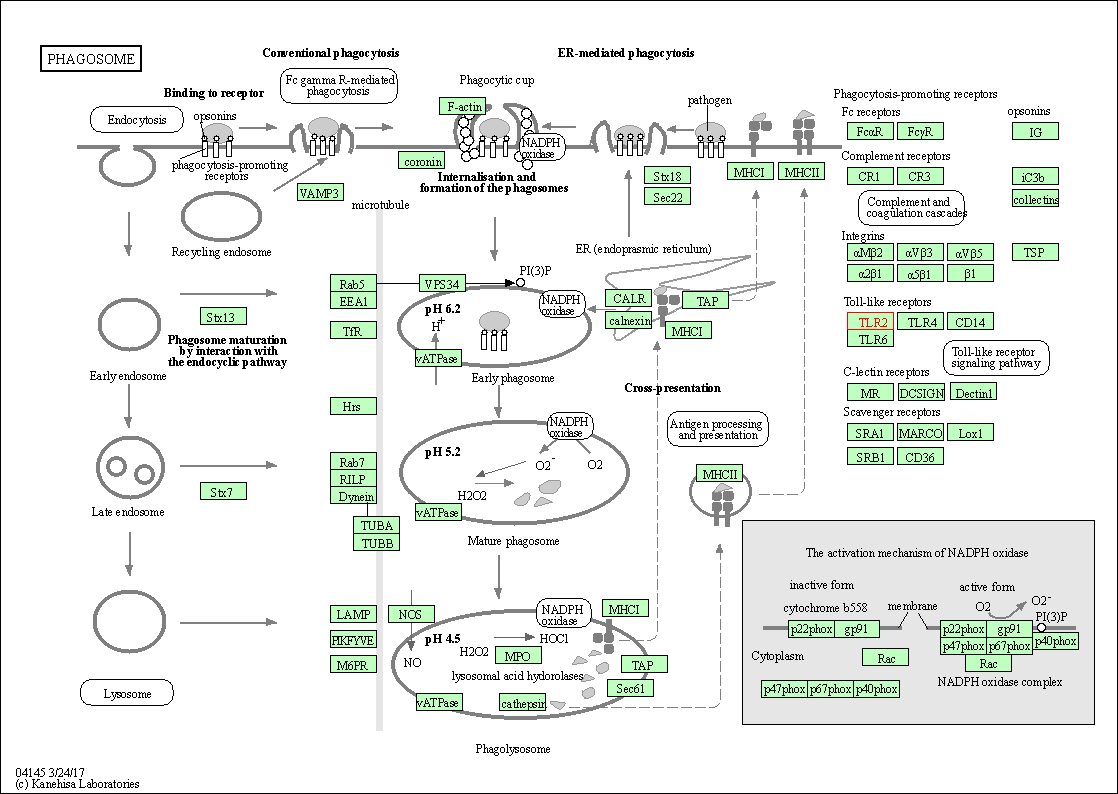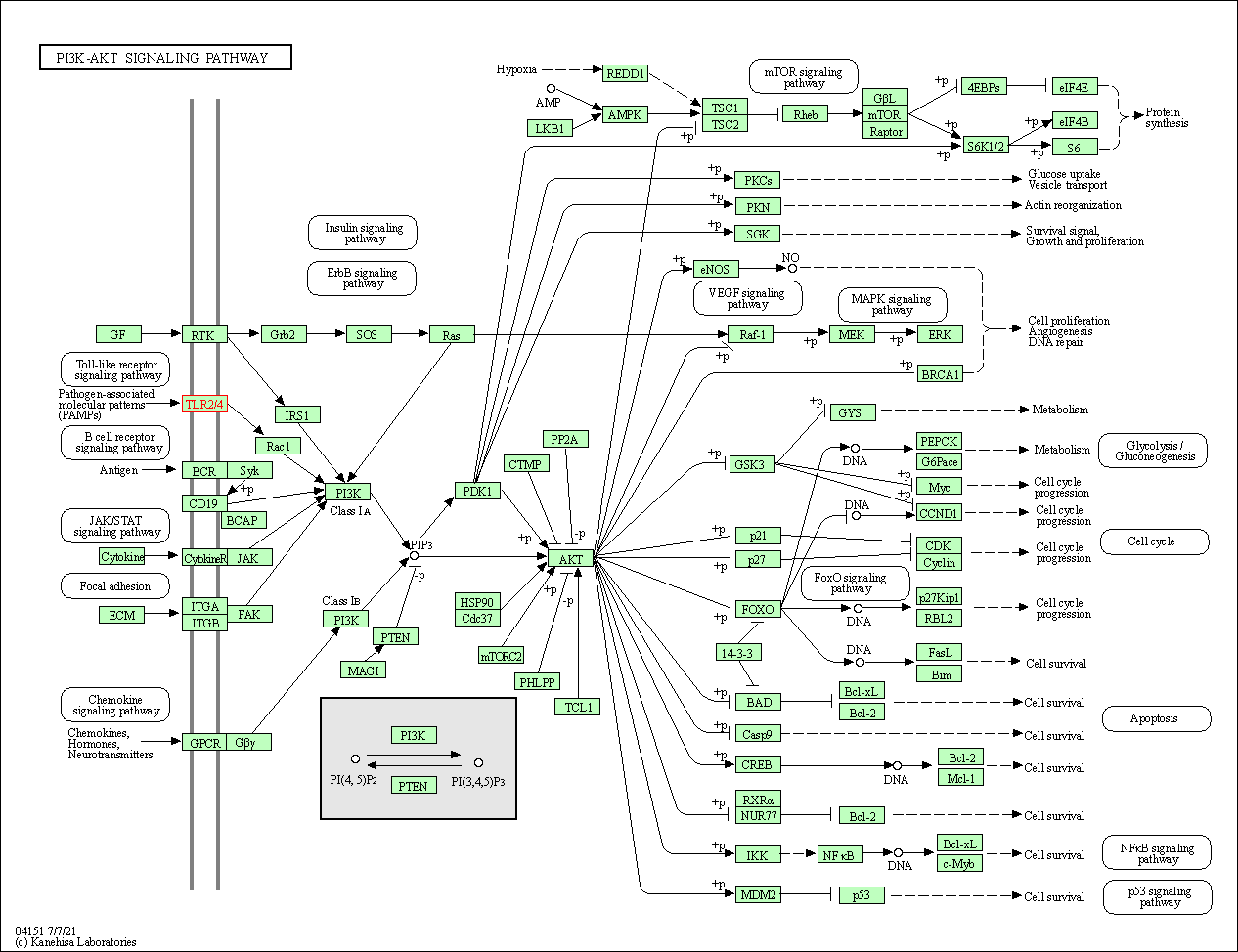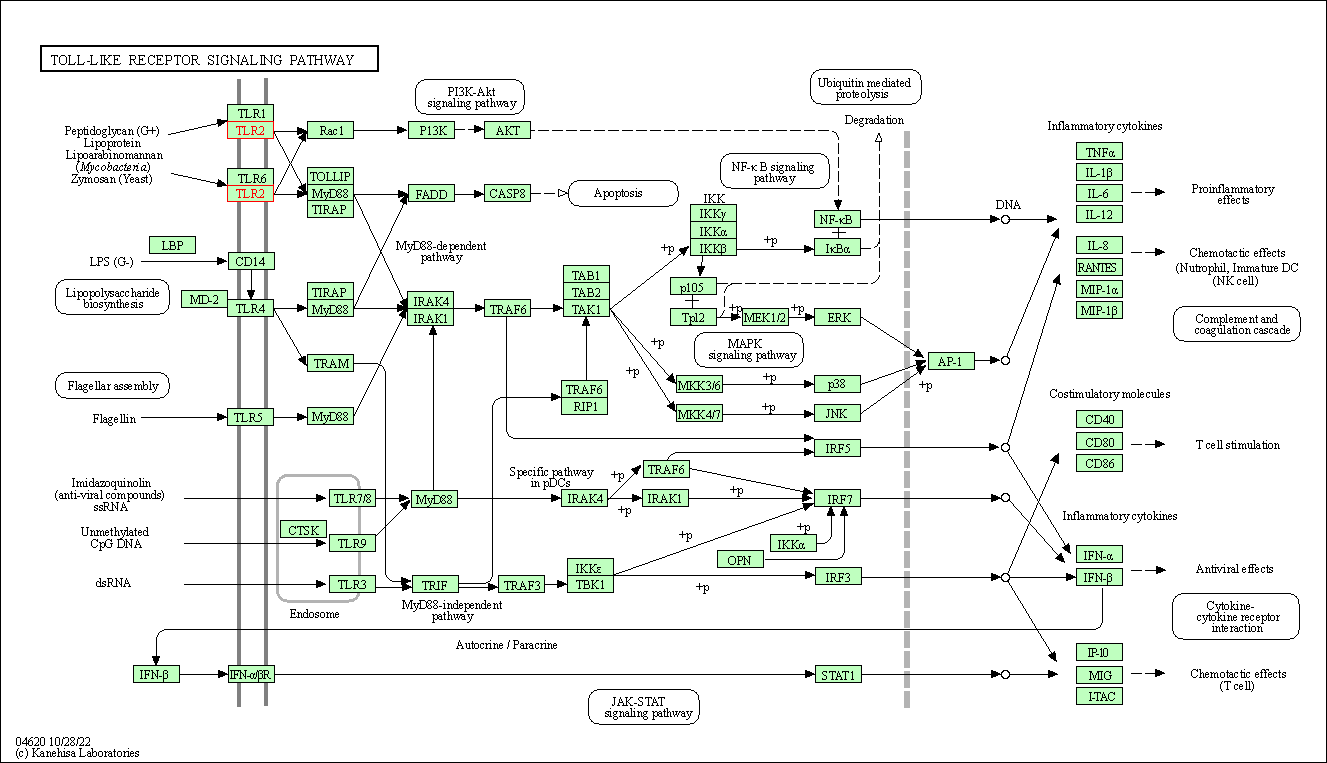Target Information
| Target General Information | Top | |||||
|---|---|---|---|---|---|---|
| Target ID |
T89083
|
|||||
| Target Name |
HUMAN toll-like receptor 2 (TLR2)
|
|||||
| Synonyms |
Toll/interleukin-1 receptor-like protein 4; TIL4; CD282
Click to Show/Hide
|
|||||
| Gene Name |
TLR2
|
|||||
| Disease | [+] 1 Target-related Diseases | + | ||||
| 1 | COVID-19 [ICD-11: 1D6Y] | |||||
| Function |
Cooperates with TLR1 or TLR6 to mediate the innate immune response to bacterial lipoproteins or lipopeptides. Acts via MYD88 and TRAF6, leading to NF-kappa-B activation, cytokine secretion and the inflammatory response. May also activate immune cells and promote apoptosis in response to the lipid moiety of lipoproteins. Recognizes mycoplasmal macrophage-activating lipopeptide-2kD (MALP-2), soluble tuberculosis factor (STF), phenol-soluble modulin (PSM) and B. burgdorferi outer surface protein A lipoprotein (OspA-L) cooperatively with TLR6. Stimulation of monocytes in vitro with M. tuberculosis PstS1 induces p38 MAPK and ERK1/2 activation primarily via this receptor, but also partially via TLR4. MAPK activation in response to bacterial peptidoglycan also occurs via this receptor. Acts as a receptor for M. tuberculosis lipoproteins LprA, LprG, LpqH and PstS1, some lipoproteins are dependent on other coreceptors (TLR1, CD14 and/or CD36); the lipoproteins act as agonists to modulate antigen presenting cell functions in response to the pathogen. M. tuberculosis HSP70 (dnaK) but not HSP65 (groEL-2) acts via this protein to stimulate NF-kappa-B expression. Recognizes M. tuberculosis major T-antigen EsxA (ESAT-6) which inhibits downstream MYD88-dependent signaling (shown in mouse). Forms activation clusters composed of several receptors depending on the ligand, these clusters trigger signaling from the cell surface and subsequently are targeted to the Golgi in a lipid-raft dependent pathway. Forms the cluster TLR2:TLR6:CD14:CD36 in response to diacylated lipopeptides and TLR2:TLR1:CD14 in response to triacylated lipopeptides. Required for normal uptake of M. tuberculosis, a process that is inhibited by M. tuberculosis LppM. Cooperates with LY96 to mediate the innate immune response to bacterial lipoproteins and other microbial cell wall components.
Click to Show/Hide
|
|||||
| BioChemical Class |
Toll-like receptor
|
|||||
| UniProt ID | ||||||
| Sequence |
MPHTLWMVWVLGVIISLSKEESSNQASLSCDRNGICKGSSGSLNSIPSGLTEAVKSLDLS
NNRITYISNSDLQRCVNLQALVLTSNGINTIEEDSFSSLGSLEHLDLSYNYLSNLSSSWF KPLSSLTFLNLLGNPYKTLGETSLFSHLTKLQILRVGNMDTFTKIQRKDFAGLTFLEELE IDASDLQSYEPKSLKSIQNVSHLILHMKQHILLLEIFVDVTSSVECLELRDTDLDTFHFS ELSTGETNSLIKKFTFRNVKITDESLFQVMKLLNQISGLLELEFDDCTLNGVGNFRASDN DRVIDPGKVETLTIRRLHIPRFYLFYDLSTLYSLTERVKRITVENSKVFLVPCLLSQHLK SLEYLDLSENLMVEEYLKNSACEDAWPSLQTLILRQNHLASLEKTGETLLTLKNLTNIDI SKNSFHSMPETCQWPEKMKYLNLSSTRIHSVTGCIPKTLEILDVSNNNLNLFSLNLPQLK ELYISRNKLMTLPDASLLPMLLVLKISRNAITTFSKEQLDSFHTLKTLEAGGNNFICSCE FLSFTQEQQALAKVLIDWPANYLCDSPSHVRGQQVQDVRLSVSECHRTALVSGMCCALFL LILLTGVLCHRFHGLWYMKMMWAWLQAKRKPRKAPSRNICYDAFVSYSERDAYWVENLMV QELENFNPPFKLCLHKRDFIPGKWIIDNIIDSIEKSHKTVFVLSENFVKSEWCKYELDFS HFRLFDENNDAAILILLEPIEKKAIPQRFCKLRKIMNTKTYLEWPMDEAQREGFWVNLRA AIKS Click to Show/Hide
|
|||||
| 3D Structure | Click to Show 3D Structure of This Target | AlphaFold | ||||
| Drugs and Modes of Action | Top | |||||
|---|---|---|---|---|---|---|
| Drugs in Phase 2 Trial | [+] 1 | + | ||||
| 1 | PUL-042 | Drug Info | Phase 2 | Coronavirus Disease 2019 (COVID-19) | [2] | |
| Mode of Action | [+] 1 Modes of Action | + | ||||
| Agonist | [+] 1 Agonist drugs | + | ||||
| 1 | PUL-042 | Drug Info | [1], [3] | |||
| Cell-based Target Expression Variations | Top | |||||
|---|---|---|---|---|---|---|
| Cell-based Target Expression Variations | ||||||
| Drug Binding Sites of Target | Top | |||||
|---|---|---|---|---|---|---|
| Ligand Name: (2r)-3-{[(2s)-3-Hydroxy-2-(Palmitoylamino)propyl]thio}propane-1,2-Diyl Dihexadecanoate | Ligand Info | |||||
| Structure Description | Crystal structure of the TLR1-TLR2 heterodimer induced by binding of a tri-acylated lipopeptide | PDB:2Z7X | ||||
| Method | X-ray diffraction | Resolution | 2.10 Å | Mutation | No | [4] |
| PDB Sequence |
SLSCDRNGIC
36 KGSSGSLNSI46 PSGLTEAVKS56 LDLSNNRITY66 ISNSDLQRCV76 NLQALVLTSN 86 GINTIEEDSF96 SSLGSLEHLD106 LSYNYLSNLS116 SSWFKPLSSL126 TFLNLLGNPY 136 KTLGETSLFS146 HLTKLQILRV156 GNMDTFTKIQ166 RKDFAGLTFL176 EELEIDASDL 186 QSYEPKSLKS196 IQNVSHLILH206 MKQHILLLEI216 FVDVTSSVEC226 LELRDTDLDT 236 FHFSELSTGE246 TNSLIKKFTF256 RNVKITDESL266 FQVMKLLNQI276 SGLLELEFDD 286 CTLNGVGNFR296 ASDNDRVIDP306 GKVETLTIRR316 LHIPRFYLFY326 DLSTLYSLTE 336 RVKRITVENS346 KVFLVPCLLS356 QHLKSLEYLD366 LSENLMVEEY376 LKNSACEDAW 386 PSLQTLILRQ396 NHLASLEKTG406 ETLLTLKNLT416 NIDISKNSFH426 SMPETCQWPE 436 KMKYLNLSST446 RIHSVTGCIP456 KTLEILDVSN466 NNLNLFSLNL476 PQLKELYISR 486 NKLMTLPDAS496 LLPMLLVLKI506 SRNQLKSVPD516 GIFDRLTSLQ526 KIWLHTNPWD 536 CSCPRIDYLS546 RWLNKNSQKE556 QGSAKCSGSG566 KPVRSIICP
|
|||||
|
|
LEU266
4.205
MET270
3.639
LEU273
4.270
LEU282
3.388
PHE284
4.057
PHE295
4.566
ASP305
4.774
PRO306
4.103
VAL309
4.005
LEU312
3.694
ILE314
4.329
LEU317
3.893
ILE319
3.901
PHE322
3.672
TYR323
4.590
PHE325
3.580
TYR326
3.672
ASP327
3.503
|
|||||
| Click to View More Binding Site Information of This Target with Different Ligands | ||||||
| Different Human System Profiles of Target | Top |
|---|---|
|
Human Similarity Proteins
of target is determined by comparing the sequence similarity of all human proteins with the target based on BLAST. The similarity proteins for a target are defined as the proteins with E-value < 0.005 and outside the protein families of the target.
A target that has fewer human similarity proteins outside its family is commonly regarded to possess a greater capacity to avoid undesired interactions and thus increase the possibility of finding successful drugs
(Brief Bioinform, 21: 649-662, 2020).
Human Tissue Distribution
of target is determined from a proteomics study that quantified more than 12,000 genes across 32 normal human tissues. Tissue Specificity (TS) score was used to define the enrichment of target across tissues.
The distribution of targets among different tissues or organs need to be taken into consideration when assessing the target druggability, as it is generally accepted that the wider the target distribution, the greater the concern over potential adverse effects
(Nat Rev Drug Discov, 20: 64-81, 2021).
Human Pathway Affiliation
of target is determined by the life-essential pathways provided on KEGG database. The target-affiliated pathways were defined based on the following two criteria (a) the pathways of the studied target should be life-essential for both healthy individuals and patients, and (b) the studied target should occupy an upstream position in the pathways and therefore had the ability to regulate biological function.
Targets involved in a fewer pathways have greater likelihood to be successfully developed, while those associated with more human pathways increase the chance of undesirable interferences with other human processes
(Pharmacol Rev, 58: 259-279, 2006).
Biological Network Descriptors
of target is determined based on a human protein-protein interactions (PPI) network consisting of 9,309 proteins and 52,713 PPIs, which were with a high confidence score of ≥ 0.95 collected from STRING database.
The network properties of targets based on protein-protein interactions (PPIs) have been widely adopted for the assessment of target’s druggability. Proteins with high node degree tend to have a high impact on network function through multiple interactions, while proteins with high betweenness centrality are regarded to be central for communication in interaction networks and regulate the flow of signaling information
(Front Pharmacol, 9, 1245, 2018;
Curr Opin Struct Biol. 44:134-142, 2017).
Human Similarity Proteins
Human Tissue Distribution
Human Pathway Affiliation
Biological Network Descriptors
|
|
|
Note:
If a protein has TS (tissue specficity) scores at least in one tissue >= 2.5, this protein is called tissue-enriched (including tissue-enriched-but-not-specific and tissue-specific). In the plots, the vertical lines are at thresholds 2.5 and 4.
|
| KEGG Pathway | Pathway ID | Affiliated Target | Pathway Map |
|---|---|---|---|
| Phagosome | hsa04145 | Affiliated Target |

|
| Class: Cellular Processes => Transport and catabolism | Pathway Hierarchy | ||
| PI3K-Akt signaling pathway | hsa04151 | Affiliated Target |

|
| Class: Environmental Information Processing => Signal transduction | Pathway Hierarchy | ||
| Neutrophil extracellular trap formation | hsa04613 | Affiliated Target |

|
| Class: Organismal Systems => Immune system | Pathway Hierarchy | ||
| Toll-like receptor signaling pathway | hsa04620 | Affiliated Target |

|
| Class: Organismal Systems => Immune system | Pathway Hierarchy | ||
| Degree | 28 | Degree centrality | 3.01E-03 | Betweenness centrality | 1.94E-03 |
|---|---|---|---|---|---|
| Closeness centrality | 2.39E-01 | Radiality | 1.42E+01 | Clustering coefficient | 1.56E-01 |
| Neighborhood connectivity | 2.49E+01 | Topological coefficient | 6.44E-02 | Eccentricity | 12 |
| Download | Click to Download the Full PPI Network of This Target | ||||
| Chemical Structure based Activity Landscape of Target | Top |
|---|---|
| Target Poor or Non Binders | Top | |||||
|---|---|---|---|---|---|---|
| Target Poor or Non Binders | ||||||
| References | Top | |||||
|---|---|---|---|---|---|---|
| REF 1 | Pulmotects lead product, PUL-042, is a clinical stage inhaled therapeutic that in preclinical studies stimulates the innate immune system in minutes to provide immediate and effective protection against all major classes of pathogens that lasts for days. | |||||
| REF 2 | ClinicalTrials.gov (NCT04312997) The Use of PUL-042 Inhalation Solution to Reduce the Severity of COVID-19 in Adults Positive for SARS-CoV-2 Infection. U.S. National Institutes of Health. | |||||
| REF 3 | TLR 2/6/9 agonist PUL-042 | |||||
| REF 4 | Crystal structure of the TLR1-TLR2 heterodimer induced by binding of a tri-acylated lipopeptide. Cell. 2007 Sep 21;130(6):1071-82. | |||||
If You Find Any Error in Data or Bug in Web Service, Please Kindly Report It to Dr. Zhou and Dr. Zhang.

